With the upcoming “temporary” changes to carry-on baggage regulations coming into effect on September 1, 2024, it’s important to be well-informed before boarding a plane. The new guidelines focus primarily on the amount of liquids that passengers are allowed to carry in their hand luggage. Despite technological advances and airport investments in more advanced security systems, some of the benefits of these innovations appear to be offset by the reintroduction of stricter regulations.
the Recent Contacts The EU’s decision on new “temporary” restrictions on hand luggage represents a major change for the aviation sector. The focus is primarily on liquids, with the maximum size allowed for hand luggage set to be re-set at 100ml. This amendment represents a revival of rules that were in place for twenty years, before larger packaging was allowed at airports with advanced detection systems.
The new regulations will be foot While many airports, including some in Spain, have recently implemented advanced scanning technologies. These systems, referred to as EDSCB, are designed to speed up the security screening process and improve the passenger experience. However, with the implementation of this new standard, one of the most important benefits of these investments will disappear.
The decision to review the rules on hand luggage is due to growing concerns about aviation safety. The EU noted that this amendment also aims to improve controls on illegal items and dangerous materials. This is in line with the current trend towards stricter safety measures in the aviation sector.
For the average traveller, the new regulations mean they once again have to consider the restrictions on taking liquids with them. This can create additional hassles, especially for those who are used to carrying larger amounts of liquids in their carry-on bags. It is therefore once again important to plan carefully so that important items such as medication, cosmetics or snacks are packed in the correct sizes.
Travelers should also be better prepared for airport screening. The need to carry liquids in smaller containers can lead to longer waits at security checkpoints, which can disrupt the overall flying experience. However, it is important for travelers to adapt to this new reality as safety will always remain the number one priority.
Under the new regulations, there are specific guidelines on the types of liquids allowed in hand luggage. Liquids must be in containers no larger than 100ml, and these containers must fit together in a clear, resealable plastic bag. This ensures that security staff can quickly and efficiently check what a traveller is carrying, without wasting any unnecessary time.
Additionally, there are exceptions to the rule for some liquids, such as medications and baby food. However, it is important for travelers to understand these exceptions and have the necessary documentation to avoid any complications.

“Coffee buff. Twitter fanatic. Tv practitioner. Social media advocate. Pop culture ninja.”











More Stories
Strong increase in gas export pipeline from Norway to Europe
George Louis Bouchez still puts Julie Tatton on the list.
Thai Air Force wants Swedish Gripen 39 fighter jets